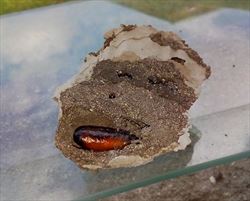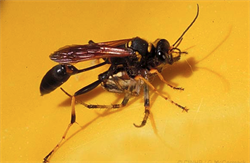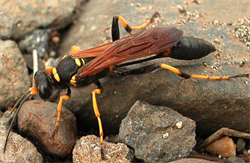Yellow-legged mud-dauber wasp. It is also known as the back-and-yellow mud-dauber, black-wasted mud-dauber.
Pacific Pests, Pathogens, Weeds & Pesticides - Online edition
Pacific Pests, Pathogens, Weeds & Pesticides
Mud-dauber wasp (534)
Scelipohron caementarium; previously, it was known as Sphex carmentarium. It belongs to the Sphecidae. (An outbreak in Rotuma, Fiji, has occurred recently, but identification of the mud-dauber species has not been officially authenticated).
Asia, North (including Hawaii), South and Central America, Europe, Oceania. It is recorded from Australia, Cook Islands, Fiji, French Polynesia, Micronesia (countries unspecified), New Zealand, New Caledonia, Samoa, and Wallis and Futuna. (A recent outbreak of this wasp or similar species has been reported from Rotuma, Fiji; it is likely to be this species as it is known from other islands in the country, and it is the only species recorded. Nevertheless, the identity is being confirmed).
Mud-daubers build nests of mud, as its name suggests, to rear their young on spiders (Photo 1). These wasps, and there are more than 30 species, live alone. The female builds the nest in shady, sheltered places, inside or outside of buildings of all kinds, including houses, on bridges, on trees, and under rocky overhangs. Mud is carried from puddles or pool edges to construct the vertically arranged nest containing up to 25 cells. After a cell is constructed, a paralysed spider is added, an egg laid on it, more spiders provisioned (up to 15), and the cell is capped. Work then begins on the next cell. After completing the nest more mud is added to protect the entire nest cluster.
Eggs hatch, larvae develop - feeding on the spiders - pupate (Photo 3) and emerge when adult by chewing through the mud walls. They feed on nectar, mate, and begin their life cycle once more. Orb, lynx, crab, jumping, and sac spiders are favourite prey, with considerable variation between individual wasps for the type they prefer.
The adult is a black wasp with yellow markings, with a characteristic back 'petiole' - the very thin structure connecting thorax with abdomen (Photos 4-6). Apart from the legs, yellow markings occur at the base of the antennae, the top of the thorax, and base of abdomen. Mostly, the abdomen is black. Adults are about 21-25 mm long, with females larger than males. Both females and males feed on nectar, and fluids of their spider prey.
Spread is on the wing, and long-distance spread associated with domestic and international trade. It is possible that spread in the Pacific has been associated with stowaway wasps on ships and planes, or their nests with immature stages transported between countries.
The mud-dauber is a household nuisance as it often builds its nest inside buildings; however, it rarely stings human beings, although stings may be painful. Its greatest impact is possibly that on biodiversity of spiders.
Look for a large (25 mm long) black and yellow insects, with long, black petioles and abdomen. Look for vertical mud nests containing cells provisioned with spiders and life stages of the wasp.
BIOSECURITY
The mud-dauber is not a pest of plants. It is an occasional nuisance to human beings: when it builds nests inside houses - but these can always be removed; and it may deliver a painful sting if handled - but this is rare and easily treated with an ice pack. The wasps are unlikely to result in structural damage. If they are a pest, they are one of spiders!
However, there is need to prevent their further introduction to Pacific island countries. Two species, Sceliphron caementarium and Sceliphron laetum, are now widely distributed in the region. This is likely to have resulted from adults stowing away on planes and ships or nests containing larvae and pupae being transported to new destinations. Therefore, biosecurity authorities should consider the pathways likely to result in their introduction and take appropriate actions to prevent their further spread. Afterall, there is nothing to be gained from their introduction: on the contrary, increased predation of spiders may lead to increased plant pests or other unforeseen impacts both to agricultural production and natural ecosystems.
BIOCONTROL
Some birds eat mud-daubers.
CULTURAL CONTROL
If there is need to control mud-daubers in the home or elsewhere, try the following:
- Break off the nest or scrape it from its support using a knife (or paint scraper); wear gloves if there is a chance of being stung by adult mud-daubers.
- Close windows of houses or if this is impractical, leave them open but close the blinds, curtains, or wooden shutters. And do the same in churches, community halls and abandoned buildings.
- Control spiders in the home. Mud-daubers are attracted to spiders, capturing them to feed to their larvae. Remove spiders' webs, and try using oils to repel spiders (eucalyptus, citronella, tea tree or lavender). There is no need to kill spiders in the home, simply capture them using a jam jar and move them to the garden.
- Attract birds to the garden. Some birds feed on mud-daubers, so attract them by putting out seeds or a water bath.
- Trap mud-daubers. Make a trap by cutting off the top 1/3 of a plastic drink bottle, fill the bottom part with water, smear the rim with jam, invert the top part into the bottom part, and hang where mud-daubers nest. (Note that many different types of insects will be attracted to the trap, and it will need to be cleaned and recharged frequently.)
CHEMICAL CONTROL
Insecticides are not recommended, nor are they necessary, cultural control measures are likely to be sufficient. However, if they do not work try sprays of peppermint oil (50:50 with water) around where they nest; this is said to be a wasp repellent.
AUTHORS Grahame Jackson & Mani Mua
Information from Ramage T, et al. (2015) The Aculeata id French Polynesia. III. Sphecidae, with the record of three new species for the Society Islands (Hymenoptera). Bulletin de la Societe entomogique de France 120(2): 157-163. Sceliphron caementarium. Wikipedia. (https://en.wikipedia.org/wiki/Sceliphron_caementarium); and from Powell E, Taylor L (2021) Back and yellow mud dauber (Sceliphron caementarium). Featured Creatures. Florida Department of Agriculture and Consumer Services, and University of Florida. (https://entnemdept.ufl.edu/creatures/MISC/WASPS/Sceliphron_caementarium.htm). Photos 1-4 Gerald McCormack. Cook Islands biodiversit. (http://cookislands.bishopmuseum.org/).
Produced with support from the Australian Centre for International Agricultural Research under project HORT/2016/185: Responding to emerging pest and disease threats to horticulture in the Pacific islands, implemented by the University of Queensland, in association with the Pacific Community.









